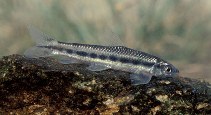| Family: |
Parodontidae (Scrapetooths) |
| Max. size: |
11.3 cm SL (male/unsexed) |
| Environment: |
benthopelagic; freshwater |
| Distribution: |
South America: Upper Paraná and upper São Francisco River basins. |
| Diagnosis: |
|
| Biology: |
Inhabits rivers and streams with rocky and sandy bottom, with water flow up to 40 cm/sec. Forages during the day, grazing on algae and preying on bottom-dwelling invertebrates. Uses its well developed pectoral fins to grip the substrate while grazing. Engages in a succession of lunges at the algal growth on rocky bottom, the mobile pedicellate upper teeth likely favoring this grazing mode. Particles thus caught are sorted out in the mouth and then either ingested or spat out. Food is often visually located and picked up. At night, fish congregates in the shallows and in fast-flowing water packs closely among the rocks. Juveniles bear a plain silvery color pattern, gradually replaced by the barred pattern of the adults (Ref. 40391). |
| IUCN Red List Status: |
Least Concern (LC); Date assessed: 07 November 2018 Ref. (130435)
|
| Threat to humans: |
harmless |
Source and more info: www.fishbase.org. For personal, classroom, and other internal use only. Not for publication.

